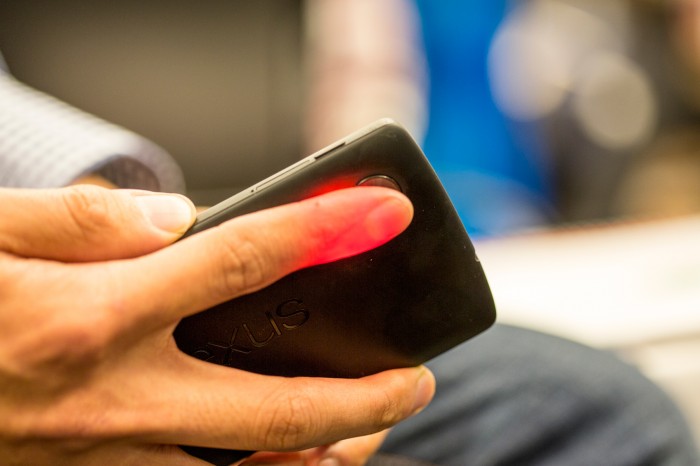How to Make a Smartphone Detect Anemia
In places where medical resources are lacking, smartphones could become indispensable medical equipment.
A new way of detecting anemia, a condition caused by a lack of oxygen-carrying red blood cells, using a smartphone camera hints at how such devices might be used to provide early warning of an illness without the need for expensive equipment or a hospital visit.
Researchers at the University of Washington will present a simple anemia-tracking technique using a smartphone and a light source at a conference later this month. Their tests suggest the device’s accuracy rivals that of an off-the-shelf, FDA-approved anemia test. The technology was developed in the lab of Shwetak Patel, a professor in the university’s electrical engineering department (see “Innovators Under 35, 2009: Shwetak Patel”).

Anemia, which can be caused by malnutrition or parasitic infection, is incredibly common in poorer countries. The World Health Organization estimates that some two billion around the world are anemic. Symptoms including dizziness, weakness, and severe headaches. Those with certain chronic conditions, such as sickle cell anemia, need to be constantly monitored, usually with frequent blood tests.
Patel is exploring various ways of harnessing the sensors on a smartphone to make simple health tests more accessible. He has developed another app that uses the device’s microphone to track a person’s breathing while he or she sleeps, and another that can detect jaundice in a newborn baby using a smartphone’s camera and a color-coded reference card. All of his systems rely on machine-learning algorithms to recognize symptoms from sensor readings.
Patel and colleagues found that the camera in a Nexus 5 smartphone could measure hemoglobin by capturing light passing through a person’s finger. The system records video as light from the phone’s flash, a small additional array of LED lights, and an incandescent lightbulb shines through a fingertip. The system was trained to recognize changes in color as blood pumps through the finger that might indicate a deficiency of red blood cells.
In tests of 31 people that were conducted in collaboration with Seattle Children’s Hospital, it was found that the new system worked as well as a commercial LED-based anemia test, the Masimo Pronto. It was not nearly as accurate as a conventional blood test, however.

Ulrich Timm, a professor at the University of Rostock in Germany who has studied the use of LED-based sensing systems for hemoglobin tracking, says the technology would have lots of practical use—providing it works as well as promised. “Such a system would be very useful for blood donation centers or home care,” he says. “Pregnant women could monitor their hemoglobin level without additional hardware.” However, Timm also questions how accurate the approach would be in practice, given the spectral resolution of most smartphone cameras.
Caroline Buckee, an assistant professor and epidemiologist at Harvard who studies ways for mobile devices to be used for global health (see “Innovators Under 35, 2013: Caroline Buckee”), says the system seems promising, but warns that it is not always simple to deploy and scale such a solution. And she agrees that accuracy would be a key concern.
“There is the issue of the penetration of smartphones,” Buckee says. “Although it would still be useful in many places where there is high smartphone penetration and lots of anemia, like India; and community health workers could use it in places without high penetration in rural areas where anemia affects many people, such as West Africa.”
Deep Dive
Artificial intelligence
Large language models can do jaw-dropping things. But nobody knows exactly why.
And that's a problem. Figuring it out is one of the biggest scientific puzzles of our time and a crucial step towards controlling more powerful future models.
Google DeepMind’s new generative model makes Super Mario–like games from scratch
Genie learns how to control games by watching hours and hours of video. It could help train next-gen robots too.
What’s next for generative video
OpenAI's Sora has raised the bar for AI moviemaking. Here are four things to bear in mind as we wrap our heads around what's coming.
Stay connected
Get the latest updates from
MIT Technology Review
Discover special offers, top stories, upcoming events, and more.